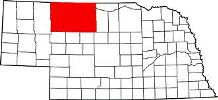Extension, Cooperative
Date of this Version
1936
Abstract
After January 1, 1936 the extension program in Cherry County has been sponsored by the Cherry County Farm Bureau. The organization of the County Farm Bureau was completed January 31, 1936. Funds made available for their use total $1345.70.
Goals accomplished were well in line with program of work at the beginning of the year.
Seven hundred three applications for corn-hog contracts were filed. Final tabulations showed that five hundred seventy-seven complied in full, forty-four complied partially, and eighty-two were refused or rejected. Total benefit payments received into the county were $166,035.95. Administrated costs of the County Association totaled $8157.62.
1865 work sheets for agricultural conservation listed data covering 3,387,977 acres of land in the county. The State Committee approved 132,076 acres as the county limit for depleting base. Five hundred operators cooperated with requirements, representing a little over 100,000 acres of the county limit. Fifteen thousand acres of the 132,076 acres are estimated as converted to conserving crops during 1936. Benefit payments are estimated in excess of $100,000.00.
Designation as drouth area was requested for Cherry County July 30, 1936. two hundred eleven were assisted by resettlement. Seventy-seven cars of cotton cake and concentrates were shipped in on two-thirds normal freight rates, saving more than $5,500.00 to producers.
A county Wild Life Conservation Council was organized and federated with state and national organizations.
37,200 Clarke-McNary seedlings were distributed to eighty-seven cooperators.
Thirty-four completed farm records were summarized and results were distributed to cooperators.
Twenty-five applications for 1936 wheat contracts were taken. Initial information concerning the rye reduction program was requested by five hundred eighteen producers.
Publicity was attained through assistance given by nine local weekly papers, carrying one hundred twenty-one news stories, and by ninety-three circular letters prepared in the county office.
Eighty-eight different boys and girls enrolled for one hundred nine projects in twelve 4-H clubs. These included three baby beef clubs, one farm account, one fix-it, one mixed club, one girls room, one poultry, and four clothing clubs.
A Junior Fair and Calf Show were sponsored by the County Farm Bureau, the Valentine business men, and the Hereford Breeders Association. One hundred fifty-two articles made up the exhibits of 4-H work. Seven baby beeves, thirty purebreds, and one hundred feeder calves were livestock exhibits. A get-together dinner was part of the program for visiting county agents, 4-H club folks, and ranchers. The feature of the show was picked lots of feeder calves, sold at auction to 4-H feeders from out-state. These will be followed to give publicity to producers.
Nineteen clubs enrolled two hundred fifty-nine adult women for home demonstration or project work. Training centers were maintained at Valentine, Mullen, and Gordon.
Six study clubs enrolled one hundred fifteen women.
Prairie dog eradication reclaimed three thousand acres of land. Seven thousand acres are reported as infested.
Two hundred bags of poison bran grasshopper bait were distributed. Some two thousand acres of crops are baited.
Nine farmers and ranchers administered bot capsules to their horses and reported successful results.
Small acreages of bindweed were located on nine farms. One farmer purchased chlorate, and will undertake complete eradication. This farm will be used as demonstration.
Approximately 2500 turkeys were consigned to Ainsworth Cooperative Marketing Association from Cherry County. Savings are estimated at from $600.00 to $800.00 by marketing through the pool rather than using local markets. Local meetings showed that finished birds were marketed without loss, and in a few cases, with a net profit, while unfinished birds were marketed with a consistent net loss.
Hog production for the county is at a very low figure. Careful choice of food grains needs emphasis to encourage a more rapid return of production to normal. One hundred thirty sheep growers were given some assistance and information concerning wool marketing. Assistance was given to vegetarian and to ranchers during the progress of the T. B. testing program. Marketing of horses last year paid high dividends to growers. A free matinee and follow-up information was presented to encourage production.
Seed testing service and location of seed supply was maintained through the planting season. This service benefited some fifty growers, having surplus seed for sale, and as many who needed to purchase supplies. Wheat variety tests conducted showed Komar and Ceres as outstanding varieties for this county. A Sorghum variety test again pointed to the advisability of planting more grain Sorghums as insurance against drouth loss of corn crops.
Seven ranchers entered the state pasture contest. Their records show decided merit in rotation grazing and supplemented seedings on lower areas to leguminous crops, including Dutch clover for limited summer grazing and red clover for meadow seedings. 1936 drouth conditions capitalized the results of careful grazing management. Experimental seedings of western wheatgrass and other dryland grasses were made. The aim is to investigate possibilities of speeding the return of abandoned fields and over grazed areas to native grass.



Comments
Courtesy Cherry County (Nebraska) Extension Office